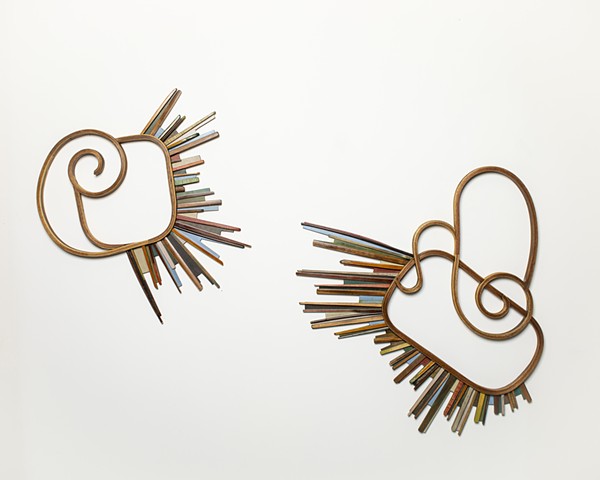Symbiotic Structures 2020
The body of work presented in Symbiotic Structures is the result of Eriksmoen engaging in an ongoing dialogue with Dr. Anne Pringle in an attempt to understand the complexities and mysteries of lichens and their unique symbiotic associations of fungi and algae. Using abandoned and broken wood furniture scavenged from streets and basements in Madison, Eriksmoen deconstructed and reconfigured timber parts following the prompt, “what would lichens do?”
Soundings (2020). Salvaged wood furniture, acrylic and milk paints, oil finish.
01/15/2020 email from Ashley Eriksmoen to Dr. Anne Pringle:
%So today I’ve been collecting and harvesting, deconstructing and separating components, cleaning by stripping off the upholstery and glue to get it all down to isolated parts. Is this what you have to do when you’re prepping your samples for experiments?
I’m looking at all these pieces on the floor and thinking about how do fungi and algae find each other and choose their partnerships? How how?%
01/17/2020 email from Dr. Anne Pringle to Ashley Eriksmoen:
%They send out chemical pings… ping ping ping and wait for answers back, then grow towards each other.
OR
A growing hyphae actively searches… finds and captures/swallows the algae. Then the algae is entrapped and must harvest CO2 for the fungus.
Which is true?
We don’t know.%
Soundings simultaneously explores both proposed hypotheses. In each individual body, or thallus, the frame-like boundary walls intersect as though one entity has been infiltrated or consumed by another. In fact, in order for fungi to extract nutrients produced by algae, their external boundaries do become permeable, and the two symbionts become entangled. The rays extending from the outer perimeters of the bodies, or thalli, are sending signals, sounding for others in order to grow towards or away from them.
